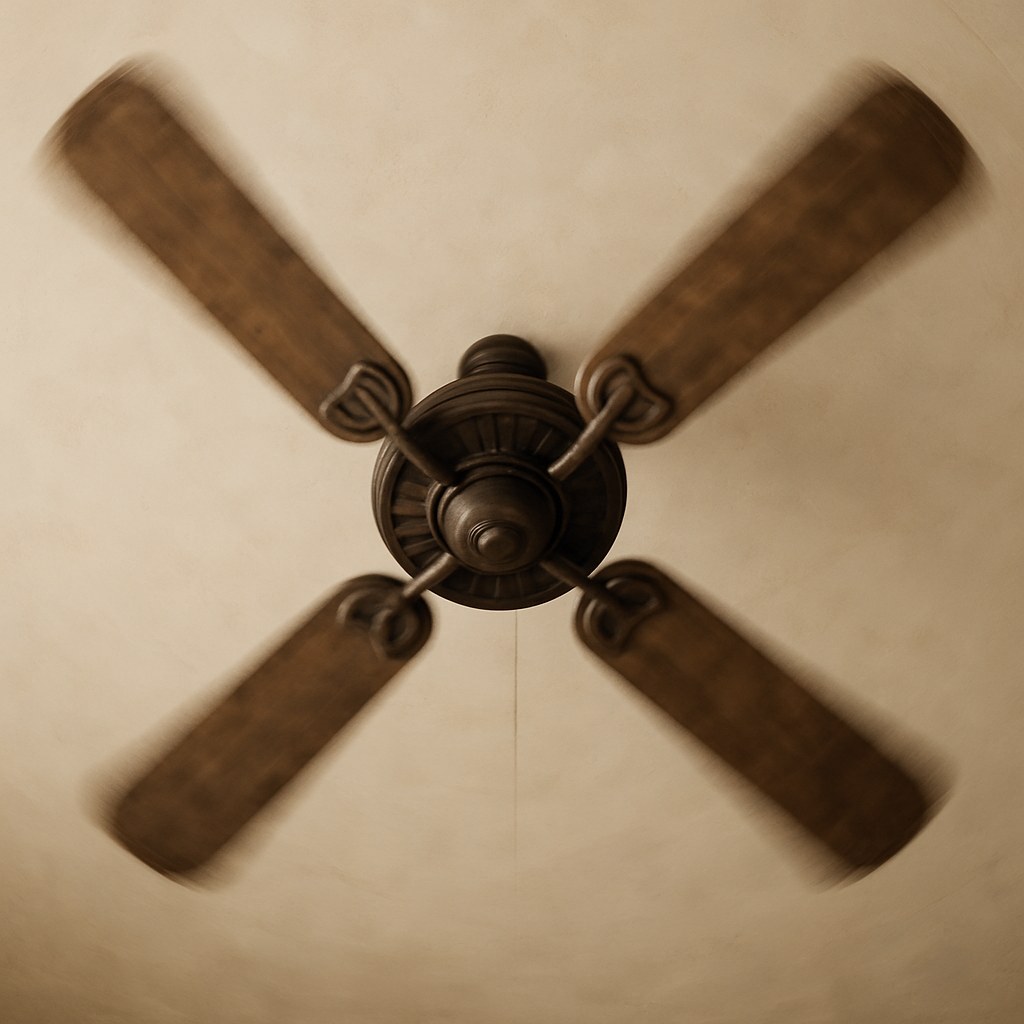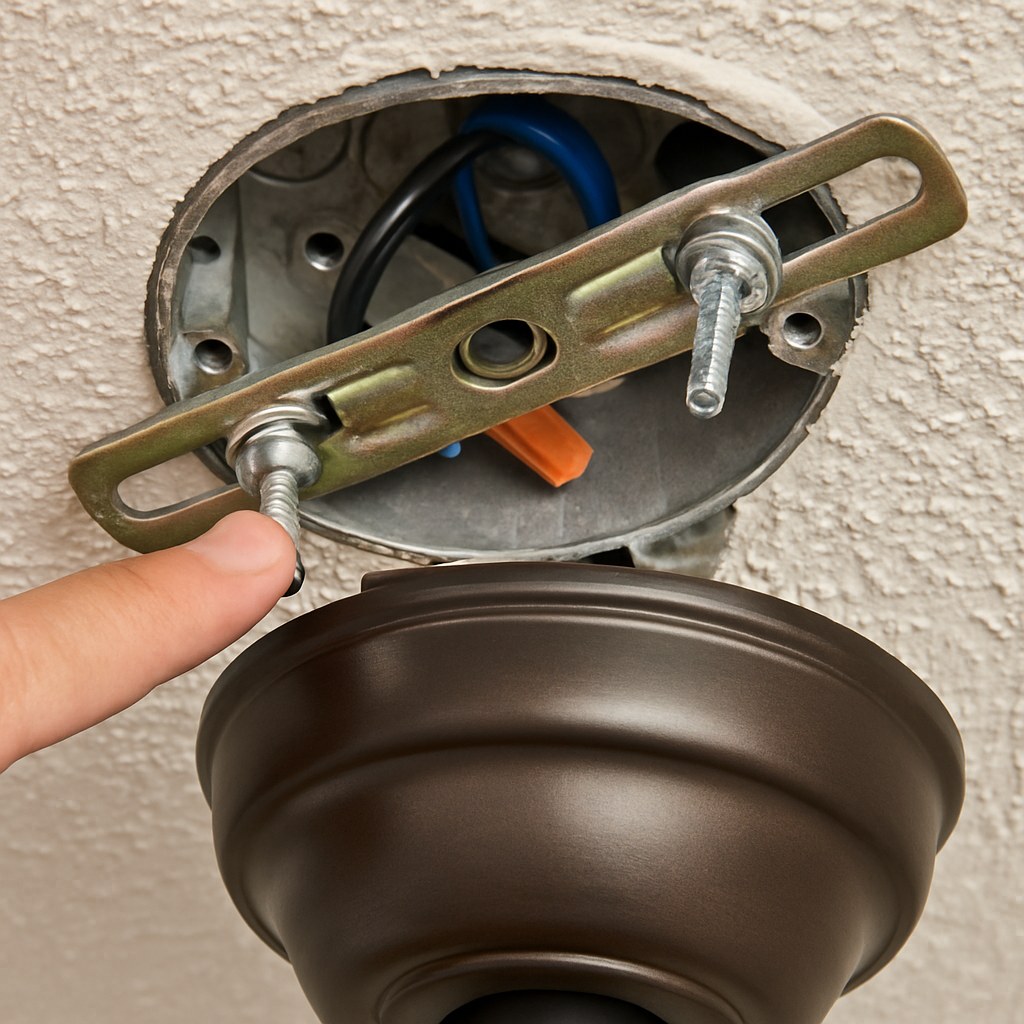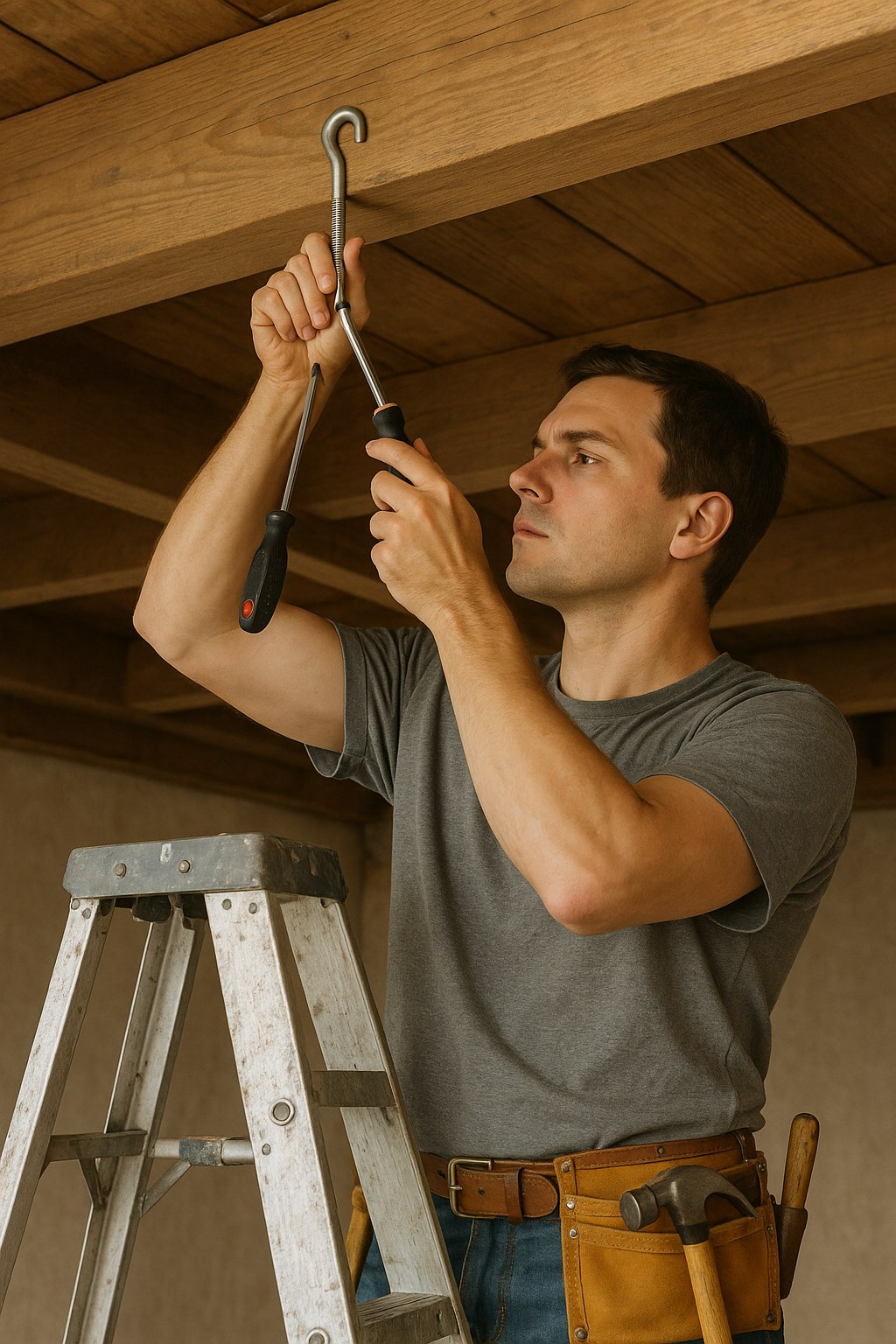That gentle wobble from your ceiling fan. The slight sag in your dining room chandelier. The flicker you notice from a loose light fixture in the hallway. These are common household annoyances that are all too easy to ignore, but they're often signs of a bigger problem. A loose ceiling fixture isn't just a cosmetic issue; it can be a serious safety hazard, posing a risk of falling or causing electrical damage.
The good news is that in most cases, you can fix a loose, wobbly, or sagging ceiling fixture yourself with just a few basic tools and a little bit of time. It’s one of those satisfying DIY projects that makes your home safer and gives you a real sense of accomplishment.
I’m here to walk you through it, just like I would over the phone. We’ll cover the essential safety steps, how to figure out what kind of fixture you’re dealing with, and the exact steps to get it secured tightly to your ceiling again.

Why Safety is Your First Priority
Before you even think about grabbing a ladder, we need to talk about safety. Any time you're working on something connected to your home’s wiring, cutting the power is non-negotiable.
Here’s your safety checklist. Do not skip these steps!
- Turn Off the Switch: Go to the wall switch that controls the fixture and turn it off. This is a good first step, but it’s not enough.
- Turn Off the Breaker: Head to your home’s electrical panel (it's usually in the basement, garage, or a utility closet). Find the circuit breaker that powers the room you’re working in and flip it to the "OFF" position. If your breakers aren’t labeled, you may need a helper to confirm you’ve turned off the right one by checking if other lights in the room are off.
- Verify the Power is Off: This is the pro step that guarantees your safety. Use a non-contact voltage tester. Simply hold the tip of the tester near the fixture’s base and wiring. If it doesn’t light up or beep, you’re good to go. If it does, go back to the breaker box and try again. These testers are inexpensive and an essential tool for any DIYer.
- Use a Sturdy Ladder: Make sure your stepladder is stable, on even ground, and tall enough that you can work comfortably without overreaching.
With the power confirmed off and your ladder in place, you’re ready to diagnose the problem.
Step 1: Identify Your Fixture Type
The solution to your wobbly fixture depends entirely on what kind of fixture it is. The mounting requirements for a heavy, vibrating ceiling fan are very different from those for a lightweight pendant lamp.
Look up at your fixture. Is it:
- A Ceiling Fan? These have blades and a motor. They are heavy and create dynamic forces, so they require special support.
- A Light Fixture? This includes chandeliers, pendant lights, flush-mount lights, and track lighting. They are wired into an electrical box but are typically lighter than fans.
- A Decorative Hanging Piece? This could be a planter, a mobile, or another non-electrical item hanging from a hook in the ceiling.
Once you’ve identified your fixture, follow the specific guide below.
How to Fix a Wobbly Ceiling Fan
A wobbling ceiling fan is the most common complaint in this category. The cause is almost always an issue with its installation or balance.
Diagnose the Mounting
- Expose the Mounting Bracket: On your ladder, locate the canopy cover—the decorative cone-shaped piece that sits flush against the ceiling. It’s usually held in place by one or two small screws. Loosen them and carefully slide the canopy down the fan’s downrod to expose the mounting hardware and the electrical box in the ceiling.
- Check the Electrical Box: This is the most important step. Look at the metal or plastic box in the ceiling that the fan bracket is attached to. It must be rated for fan support. Often, it will be stamped with "Rated for Fan Support" or similar wording. Ceiling fans are heavy and vibrate, so they require a special box that is secured directly to a ceiling joist or a support brace. A standard plastic electrical box is not strong enough.
- Wiggle the Box: Gently try to move the electrical box itself. If it’s firmly attached to a joist, it shouldn't move at all. If the box wiggles, it’s not secure, and this is the source of your problem.
Is the box fan-rated and secure? If yes, proceed to the next step. If no, stop immediately. Installing a fan on an improper box is dangerous. According to experts at This Old House, this is a common installation error that must be corrected. You’ll need to call an electrician to install a fan-rated electrical box. This is not a beginner’s task, as it involves working inside the ceiling.

Tighten All the Screws
If the box is secure, the wobble is likely coming from loose connections.
- Tighten Bracket Screws: Using a Phillips screwdriver, tighten all the screws that connect the fan’s mounting bracket to the electrical box. They should be very snug.
- Tighten Downrod Screws: Look at the downrod (the pipe connecting the fan motor to the mounting bracket). You'll see several set screws. Tighten these as well.
- Check Blade Screws: While you're up there, check the screws holding each fan blade to its bracket (the "blade iron") and the screws holding the blade irons to the motor housing. Loose blades are a common cause of wobbling.
- Reassemble and Test: Slide the canopy cover back up and secure it. Go turn the breaker back on, flip the switch, and run the fan. Watch it for a minute.
If the wobble is gone, congratulations! You’ve fixed it. If it still wobbles, the issue might be unbalanced blades. You can buy a simple fan balancing kit online or at a hardware store to fix this. However, if the wobble is severe, it's best to call a ceiling fan specialist or electrician.
How to Fix a Sagging Light Fixture
A loose light fixture often hangs slightly away from the ceiling or moves when you touch it. Let’s get it secured.
Diagnose the Mounting
- Expose the Mounting Screws: You’ll likely need to remove a glass shade, cover, or decorative cap to get to the base of the fixture. These are usually held on by small thumbscrews.
- Check the Electrical Box: With the mounting screws visible, gently push up on the base of the light fixture. Watch the electrical box in the ceiling. Does the box itself move, or just the fixture?
If the electrical box moves, this is your problem. The box has come loose from the ceiling joist. Securing it properly is a job for an electrician, as it may require work inside the ceiling.
If the box is solid and only the fixture is loose, this is an easy fix!
Tighten the Mounting Screws
- Tighten the Screws: You'll see two long screws connecting the fixture’s base to a metal mounting strap, which is in turn attached to the electrical box. Use your screwdriver to tighten these screws evenly until the base of the fixture is snug and flush against the ceiling.
- Reassemble and Test: Re-attach the cover or shade. Restore power at the breaker and turn on the light. Gently tap the fixture to make sure it’s completely solid.
If the fixture is still loose after tightening, the mounting screws might be stripped or the mounting strap might be damaged. At this point, it’s wise to consult an electrician.
How to Fix a Loose Decorative Hanging Piece
This is the simplest fix of all since there’s no electricity involved!
Diagnose the Mounting
- Check the Anchor Point: Get on your ladder and look closely at how the piece is hanging. Is the hook screwed directly into a solid wood ceiling joist, or is it just in the drywall?
- The Joist Test: A hook screwed only into drywall cannot support much weight and will eventually pull loose. You need to anchor heavy items to a ceiling joist (the structural wood beams in your ceiling). You can find a joist with a stud finder or by tapping on the ceiling and listening for a solid sound.
If the hook is already in a joist, it probably just needs to be tightened. If it's only in drywall, it needs to be moved to a joist.

Tighten or Replace the Hook
- Remove the Item: Carefully take down the decorative piece and set it aside.
- Tighten the Hook: Try turning the hook clockwise to tighten it. If it snugs up firmly, you’re done!
- Address a Spinning Hook: If the hook just spins in place, the wood fibers are stripped. Back it out and replace it with a new hanging hook or screw that is slightly larger in diameter. This will give it fresh wood to bite into.
- Re-hang and Test: Put your decorative piece back on the hook and give it a gentle wiggle to ensure it’s secure.
If you can’t get a hook to feel secure, or if you’re hanging a particularly heavy object, it may be best to call a handyman to ensure the support is adequate.
DIY vs. Hiring a Pro: Cost and Time
Fixing a loose fixture yourself is incredibly cost-effective.
- DIY Cost: Potentially $0 if you already own a screwdriver and a ladder. At most, you might spend $5 on a new mounting hook or $15 on a voltage tester.
- Professional Cost: According to Angi, hiring an electrician to install or replace a ceiling fixture can range from $150 to $350 or more, depending on the complexity of the job. If they need to install a new fan-rated box, the cost could be higher.
For a simple tightening job, you’re looking at about 20-30 minutes of work. It’s a small investment of time that saves you money and provides peace of mind.
Take Control of Your Home Maintenance
You did it! By following these steps, you’ve made your home safer and tackled a common household repair. This is what being a confident homeowner is all about.
For your next project, don't go it alone. Download the Casa app today! Casa provides clear, step-by-step guides for hundreds of home repairs, helps you keep track of maintenance, and can connect you with trusted, vetted professionals right in your area if you decide a job is better left to the experts. Take the guesswork out of homeownership and let Casa be your partner in creating a safe and well-maintained home.


